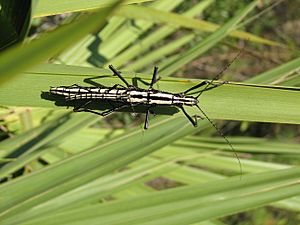Southern two-striped walkingstick facts for kids
Quick facts for kids Southern two-striped walkingstick |
|
|---|---|
 |
|
| White color form | |
| Scientific classification | |
| Kingdom: | |
| Phylum: | |
| Class: | |
| Order: | |
| Family: |
Pseudophasmatidae
|
| Genus: |
Anisomorpha
|
| Species: |
A. buprestoides
|
| Binomial name | |
| Anisomorpha buprestoides (Stoll, 1813)
|
|
The Southern Two-striped Walkingstick (scientific name: Anisomorpha buprestoides) is a fascinating insect. People also call it the devil rider or musk mare. It's a type of stick insect, which are also known as "phasmids" or "walkingsticks" because they look like twigs. You can find this insect living in the southeastern parts of the United States.
This walkingstick is quite large and sturdy for a stick insect. It's usually brown with three clear black stripes running down its body. Female walkingsticks are bigger, about 6.7 centimeters (2.6 inches) long. Males are smaller and thinner, usually around 4.1 centimeters (1.6 inches) long.
How It Defends Itself
This amazing insect is famous for its powerful defense spray. When it feels threatened, it shoots a special chemical from glands near its head. This spray can be quite strong!
The name "Devil rider" likely comes from this defense spray. It also comes from how they are often seen. In late summer and fall, these insects are active adults and are usually found in mating pairs. The smaller male rides on the back of the larger female, making it look like one insect riding another.
Scientists first studied this insect's chemical defense. They found that its spray mainly contains a chemical called "anisomorphal."
Different Colors of Walkingsticks
The Southern Two-striped Walkingstick comes in three different color forms. These colors depend on where the insect lives.
- Brown form: This one is mostly dark brown with lighter brown stripes.
- White form: This form is jet black with bright white stripes.
- Orange form: This one is, as you guessed, orange!
The white and orange forms are only found in specific, smaller areas of Florida. Each color form acts a little differently. For example, they might gather in groups in unique ways, be active at different times of the day, or lay their eggs in special places. These behaviors match the environment where they live.
Scientists have also found that the chemical spray from these different color forms can be slightly different. The white and orange forms mostly produce "anisomorphal." The brown form might produce anisomorphal or a similar chemical called "peruphasmal," depending on the group. Young brown walkingsticks (called nymphs) produce a mix of these chemicals.
Scientists also discovered that the defense spray of this walkingstick, and other stick insects, contains glucose (a type of sugar). This sugar might be part of how the insect creates these special defense chemicals.
See also
 In Spanish: Anisomorpha buprestoides para niños
In Spanish: Anisomorpha buprestoides para niños


